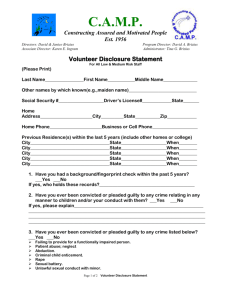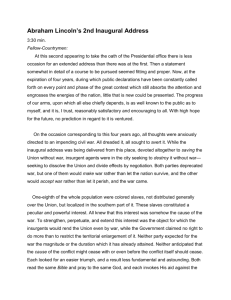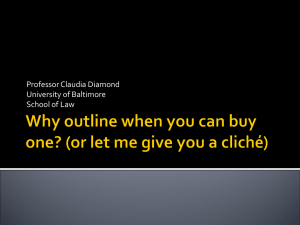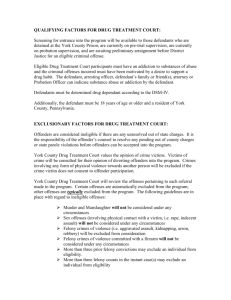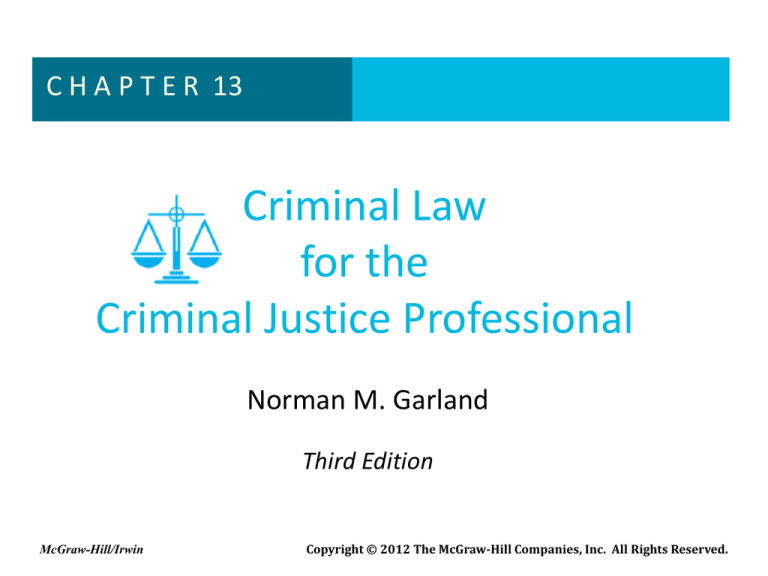
C H A P T E R 13
Criminal Law
for the
Criminal Justice Professional
Norman M. Garland
Third Edition
McGraw-Hill/Irwin
Copyright © 2012 The McGraw-Hill Companies, Inc. All Rights Reserved.
C H A P T E R 13
Slide 13-2
13.1
13.2
Crimes against
Public Order,
Safety, and Morality
Public Order and Safety Offenses
Public Morality Offenses
CHAPTER OBJECTIVES
Slide 13-3
1.
2.
3.
4.
Define the crimes that
encompass breaching the peace.
State the purpose and
elements of nuisance crimes.
Understand the most common traffic
offenses and explain their distinctions.
Name typical circumstances
that could constitute a weapons offense.
CHAPTER OBJECTIVES
Slide 13-4
continued
5.
6.
7.
8.
Explain and understand obscenity offenses.
Understand the crime of
prostitution and the parties involved.
Explain the crime of sodomy.
Distinguish legal from illegal gambling.
Slide 13-5
13.1 Public Order
and Safety Offenses
public order and safety offenses
Offenses designed to protect the general
public by dealing with behavior that is not
necessarily immoral, but nonetheless affects
the peace and safety of the community.
Slide 13-6
13.1 Public Order
and Safety Offenses
mala prohibita
Crimes defining conduct
that is wrong only
because the law says
it is wrong, in order
to protect the general
public.
mala in se
Crimes (such as rape
and murder) that are
inherently wrong.
Slide 13-7
Offenses That
Create a Public Disturbance
unlawful assembly
A gathering together of three or more persons
with the common intent to achieve a lawful
or unlawful purpose in a tumultuous manner.
rout
An unlawful assembly that
is escalating toward, but
does not reach, the level of
a riot; an attempted riot.
Slide 13-8
Offenses That
Create a Public Disturbance
riot
A tumultuous disturbance of the peace by three or more
persons assembling together in the execution of a lawful
or unlawful act and committing it in a violent and
turbulent manner.
disorderly conduct
A loosely defined offense addressing behavior that
disturbs the safety, health, or morals of others, or that is
intended only to annoy another person.
Slide 13-9
Offenses That
Create a Public Disturbance
vagrancy
A crime that is vaguely
defined as being idle or
wandering without a
visible means of support;
no longer a crime in most
jurisdictions because of the
unconstitutionality of past
vagrancy laws.
Nuisances
Slide 13-10
• Behavior that
otherwise might be
charged as a
nuisance may
also be subject
of action for
disorderly conduct
nuisance
Anything that endangers
life or health, gives offense
to the senses, violates laws
of decency, or obstructs
the reasonable and
comfortable use of
property.
abatement
The ending or eliminating
of a nuisance.
Traffic Violations
Slide 13-11
• Speeding
– Violation of speeding exists to ensure a
safe and orderly flow of traffic on streets
– Defense that car’s speedometer was
broken will have no effect on outcome
• Reckless Driving
– Must prove that
defendant could
reasonably foresee
death or injury
might occur
reckless driving
Driving with voluntary and
wanton disregard for the
safety of persons or
property.
Traffic Violations
Slide 13-12
• Failure to Stop
– S/he is directed to stop by duly authorized
officer but willfully refuses or fails to do so
• Hit and Run
– Elements of hit and run include:
• Involvement in an accident resulting in
injury or death or damage to a vehicle
• Failure to stop and furnish information about
one’s identity and that of the vehicle
• Failure to render assistance to and give immediate
notice of the accident to the police
Traffic Violations (continued)
Slide 13-13
• Driving with a Suspended
or Revoked License
– Person caught driving with
suspended license may receive
an additional suspension or revocation
Traffic Violations (continued)
Slide 13-14
– Defendant does not have to actually
drive the car in order to be convicted
– Almost every state specifically allows DUI
cases to be tried before a jury of one’s peers
because of the seriousness of penalties
driving under the influence (DUI)
Operating a motor vehicle while under the influence of a
substance or with a blood or breath alcohol concentration
above a prohibited level.
Traffic Violations (continued)
Slide 13-15
• DUI Manslaughter
– Many statutes declare defendant guilty if:
• Someone was killed by the defendant’s vehicle
• Defendant was under the influence
• And either the defendant’s faculties
were impaired or defendant
had unlawful blood alcohol level
DUI manslaughter
Causing the death of a human being by reason
of operation of a motor vehicle while under
the influence of alcohol or drugs.
Traffic Violations (continued)
Slide 13-16
• Vehicular Manslaughter
– Killing of another by operating a
motor vehicle in a reckless manner
• Vehicular Homicide
– Person can be convicted of
murder with a motor vehicle if:
• Driver uses vehicle as the murder weapon
• With deliberation and premeditation and with
malice aforethought, drives over or strikes a
person with specific intent of killing him or her
Weapons Offenses
Slide 13-17
• Weapons offense can include:
– Underage possessor
– Use of an unregistered weapon
– Not having permission to carry a weapon in
the location in which it was discovered
– Possession or transportation of an explosive,
firearm, or ammunition to commit a crime
– Placing another person in fear
– Offensive bodily contact with a weapon
– Using a firearm as a weapon (such as a club)
Weapons Offenses
Slide 13-18
• Deadly or Dangerous Weapons
– Includes guns,
swords, bowie
knives, pocket
or folding knives,
chisels, large stones,
heavy iron weights,
heavy pistols,
and automobiles
firearm
Any weapon that can, is
designed to, or may readily
be converted to expel a
projectile by the action of
an explosive; the frame or
receiver of any such
weapon; any firearm
muffler or firearm silencer.
Weapons Offenses
Slide 13-19
assault weapon
One of the prohibited
weapons named by federal
legislation, such as rifles
with conspicuous pistol
grips, pistols with shrouds,
and shotguns with a higher
ammunition capacity.
Weapons Offenses
Slide 13-20
• Firearms Owners Protection Act of 1986
– Also known as National Firearms Act (NFA)
– For conviction under NFA, prosecution must
prove violation was willful or intentional
• State Firearms Laws
– Most states have constitutional provisions
guaranteeing the right to keep and bear arms
– Most states restrict possession
of firearms by convicted felons
Application Case
Slide 13-21
– 13.1
– 13.2
Papachristou v. City of Jacksonville
Arcara v. Cloud Books, Inc.
Figure 13.1:
Slide 13-22
Various States’ Assault Weapons Laws
13.2 Public Morality Offenses
Slide 13-23
• Considerable public debate about
whether some of these offenses,
such as gambling, prostitution, and
sodomy, are victimless crimes
and should be decriminalized
Obscenity
Slide 13-24
• First federal obscenity law
resulted from circulation of French
postcards in mid-19th century
• Comstock Act of 1873
prohibited use of the mail
to convey obscene material
Obscenity
Slide 13-25
• Federal Law and Obscenity Tests
– Regina v. Hicklin
– Roth v. United States
• Tripartite test
– Memoirs v. Massachusetts
– Federal and state governments enacted laws
making it a criminal offense to produce,
distribute, or exhibit obscene
Obscenity
Slide 13-26
• Obscenity and the Model Penal Code
– MPC: material is obscene if its:
• predominant appeal is to a shameful or
morbid interest in nudity, sex, or excretion
• it goes substantially beyond customary limits of
candor in describing or representing such matters
– Obscenity and the Internet
– Telecommunications Act of 1996
banned transmission of obscene
materials to minors via broadcast media
Obscenity
Slide 13-27
• Child Pornography
– Highly organized, multimillion-dollar industry
– Protection of Children from Sexual
Exploitation Act of 1977 prohibited
production of sexually explicit
material using a child under the age of 16
if such material was destined for, or had
already traveled in, interstate commerce
Obscenity
Slide 13-28
• Child Pornography (continued)
– Child Protection Act of 1984
• Eliminated requirement that child pornography
distribution be undertaken for commerce,
criminalizing distribution for any reason
• Eradicated former obscenity test requirements
so that any pornography can be prosecuted.
• Raised the age of protected persons to 18
• Current federal law prohibits using a minor
to engage in any sexually explicit conduct
to produce a visual depiction of that conduct
Indecent Exposure
Slide 13-29
indecent exposure
An offensive display of one’s body in public, especially the
genitals or the female breasts.
exhibitionism
Repeated intentional acts
of exposing the genitals to
an unsuspecting stranger
or strangers for the
purpose of achieving
sexual excitement.
Indecent Exposure
Slide 13-30
• Many state laws and municipal ordinances
contain provisions
that permit exceptions to
indecent exposure statutes, such
as partial or full nudity during
public entertainment to
which only adults are invited
Slide 13-31
Prostitution,
Solicitation, and Pandering
prostitution
A crime that is committed
when one person agrees to
engage in sexual or deviate
sexual intercourse in return
for something of value,
usually money.
Mann Act
A federal act that prohibits
the knowing transportation
in interstate or foreign
commerce of any
individual, male or female,
with the intent that such
individual engage in
prostitution or in any
sexual activity.
Slide 13-32
Prostitution,
Solicitation, and Pandering
• Solicitation
• Patronizing a
Prostitute
– Ordinarily, offense
of patronizing A
prostitute is
punishable as
prostitution,
usually a
misdemeanor
solicitation
The act of offering
to pay another, or
receive payment
from another, for sex.
Slide 13-33
Prostitution,
Solicitation, and Pandering
• Pimping and
Pandering
– Promoting, pimping,
and pandering
generally forbidden
by state statutes
pimping
Promoting prostitution,
living off the earnings of
prostitutes, and in some
cases coercing individuals
to work as prostitutes.
pandering
Either procuring a
prostitute for a place of
prostitution or procuring a
place for a prostitute to
engage in prostitution.
Slide 13-34
Adultery, Fornication,
and Illicit Cohabitation
adultery
Sexual relations with
someone other than a
spouse when the person is
married.
fornication
Voluntary, unlawful sexual
intercourse under
circumstances not
constituting adultery.
Slide 13-35
Adultery, Fornication,
and Illicit Cohabitation
• In some states, fornication is no longer
a recognized offense but adultery is
– Utah: any unmarried person who
voluntarily engages in sexual intercourse
with another is guilty of fornication
– Idaho: any unmarried person who has
sexual intercourse with an unmarried person
of the opposite sex is guilty of fornication
– Minnesota: sexual intercourse constitutes
adultery only when woman is married party
Sodomy and Related Offenses
Slide 13-36
sodomy
The unlawful sexual
penetration of the anus of
one person by the penis of
another.
• Lawrence v. Texas: U.S. Supreme
court declared state sodomy
laws a violation of due process
Gambling
Slide 13-37
• Betting and wagering are used
interchangeably, and they apply only to
forms of gambling that are not lotteries
– All states have at
least some laws
prohibiting gambling
– federal statutes
also limit gambling
gambling
The act of staking or risking
something of value on the
outcome of a contest of
chance, or on a future
event of chance that is not
under the gambler’s
control or influence.
Application Case
Slide 13-38
– 13.3
– 13.4
– 13.5
– 13.6
– 13.7
United States v. Thomas
United States v. Maxwell
United States v.
United States District Court
People v. Garrison
State v. Tookes
Lawrence v. Texas
Figure 13.2:
Slide 13-39
Human Trafficking

